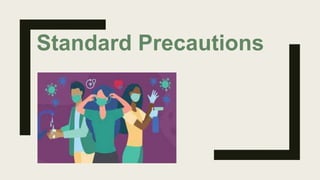Standard precautions are the minimum infection prevention practices that should be used for all patient care to protect healthcare workers and prevent the spread of infections. They include proper hand hygiene, use of personal protective equipment like gloves, gowns and masks, respiratory hygiene and cough etiquette, safe handling of equipment and waste, and cleaning and disinfection of surfaces. Standard precautions aim to assume all patient body fluids could be infectious and help minimize exposure to hazards in the healthcare setting.


































































































![References
■ CDCs Guideline for Hand Hygiene in Health-Care Settings
file:///C:/Users/mhule/AppData/Local/Microsoft/Windows/INetCache/IE/E9B9P01
K/rr5116.pdf
■ https://www.cdc.gov/injectionsafety/ip07_standardprecaution.html
■ https://main.icmr.nic.in/sites/default/files/guidelines/Hospital_Infection_control_g
uidelines.pdf
■ Transmission-based precautions. In: Infection Prevention and Control [online
course series]. Geneva: World Health Organization; 2021
(https://openwho.org/channels/ipc).
■ National Guidelines for Infection Prevention and Control in Healthcare Facilities
■ Infection control manual ,AIIMS](https://image.slidesharecdn.com/standardprecautions-240112033100-1ca9d14a/85/standard-precautions-pptx-99-320.jpg)






